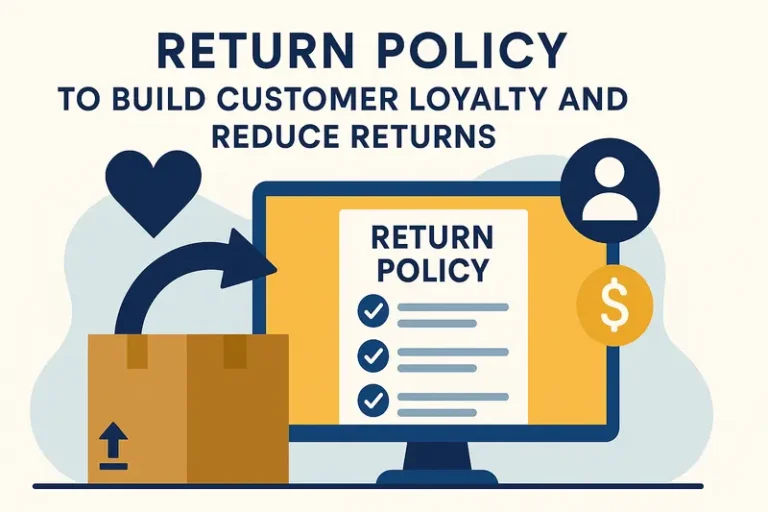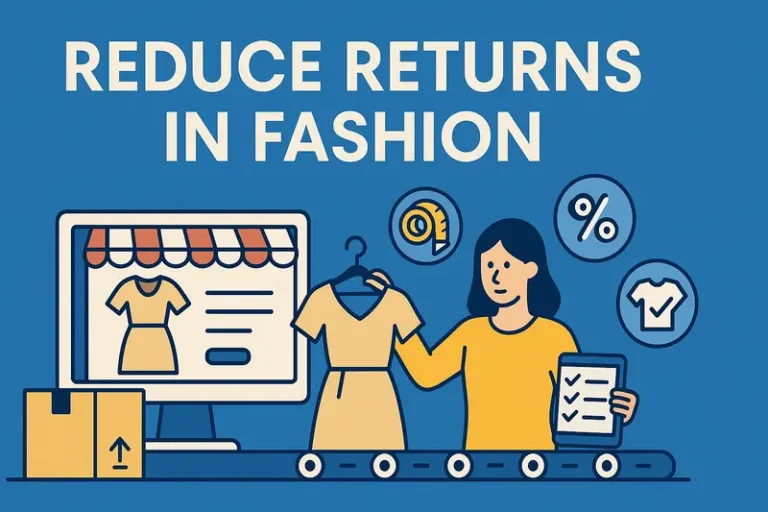Step-by-Step Guide: Reducing Ecommerce Returns With Better Product Descriptions

Last updated on April 30, 2025

In this article
 17 minutes
17 minutes
- Key Takeaways
- Accurate Product Descriptions
- High-Quality Product Images and Videos
- Implement Detailed Size Charts
- Clear Delivery Expectations
- Memorable Unboxing Experiences
- Analyze Returns Data
- Customer Feedback Integration
- Easy-to-Use Return Process
- Educate Customers on Product Use
- Encourage Exchanges Over Returns
- Prevent Shipping Damages
- Combat Return Fraud
- Enhance Customer Communication
- Sustainable Return Practices
- Regular Audits and Improvements
- Summary
- Frequently Asked Questions
Dealing with frequent product returns? Learn how to reduce product returns with actionable tips in this guide. We’ll cover everything from accurate product descriptions to customer communication, helping you improve satisfaction and reduce returns.
Key Takeaways
- Accurate and detailed product descriptions, along with high-quality images and videos, significantly reduce ecommerce returns by setting correct customer expectations.
- Implementing clear size charts and return policies enhances customer satisfaction and lowers return rates, promoting confident purchasing decisions.
- Engaging in customer feedback integration and regular audits ensures continuous improvement in product offerings and customer experience, effectively minimizing returns.
Accurate Product Descriptions
Accurate product descriptions are crucial for a successful ecommerce store. They set correct expectations, helping customers know exactly what they’re purchasing, which significantly reduces return rates. When customers understand product details, they are less likely to face disappointment related to size, color, or quality, and thus, less likely to return items. Clear and detailed product descriptions enhance customer satisfaction, decrease the likelihood of returns, and improve overall customer experience.
Enriched details, high-quality images, and multimedia content in product descriptions boost customer satisfaction and aid better product management and inventory control. This reduces the chances of customers returning items due to receiving the wrong item or one that doesn’t meet their expectations. Misleading or inaccurate descriptions can frustrate customers, leading to negative reviews and fewer repeat purchases.
Product descriptions should be accurate, consistent, and clear to set the right expectations. This approach not only reduces returns but also builds customer loyalty and trust. An ecommerce site with reliable product information can lead to better customer satisfaction and fewer returns, ultimately resulting in cost savings and improved profit margins.
Provide Detailed Specifications
Detailed specifications in product descriptions are vital and extremely important. Include critical details like size, color, material, functionality, warranties, care instructions, and compatibility. This comprehensive information educates customers, allowing them to make informed decisions and significantly reducing the likelihood of returns.
Showcasing clothing on models of different body types can help customers visualize the fit better, decreasing the chances of returns due to sizing issues. Automation in product management can also reduce errors in product details, further minimizing returns.
Detailed product reviews with specific customer details about product quality can assist future customers in making informed decisions, ultimately leading to fewer returns.
Address Common Misconceptions
Addressing common misconceptions in product descriptions is crucial for reducing returns. Misunderstandings about product representation often lead to returns. Correcting these misconceptions provides customers with a better understanding of the product, leading to more confidence in their purchases and reducing the chances of returns due to mismatched expectations.
This proactive approach can significantly enhance customer satisfaction and loyalty.
Optimize for Mobile Devices
Optimizing product descriptions for mobile devices is vital in today’s mobile-first world. Clear and concise descriptions that are scannable improve readability and customer satisfaction, leading to better conversions.
Mobile optimization sets clear expectations, reducing the likelihood of returns due to misunderstandings about the product. Making product descriptions mobile-friendly helps ecommerce sites save time and enhance the overall customer experience.
Make Returns Profitable, Yes!
Cut shipping and processing costs by 70% with our patented peer-to-peer returns solution. 4x faster than traditional returns.
See How It WorksHigh-Quality Product Images and Videos
High-quality product images and videos are a game-changer for any online store. They provide a better understanding of the product, significantly reducing the chances of returns. High-quality visuals and engaging content enhance customer trust and improve conversions by setting accurate expectations.
When customers can see the product in augmented reality from multiple angles and in various settings, they are more likely to be satisfied with their purchase.
Multiple Angles and Settings
Displaying products from multiple angles and in various settings is key to improving conversion rates and reducing customer surprises. Accessible image presentation, rather than hiding images in a carousel, is crucial for customer engagement and satisfaction.
This comprehensive view helps customers set accurate expectations, reducing the likelihood of returns.
Diverse Models for Apparel
Showcasing apparel on models of various body types helps customers visualize how clothing will fit them. This strategy reduces returns by ensuring shoppers find the right fit and feel more confident in their purchasing decision.
For an ecommerce business, this translates into fewer ecommerce returns and happier customers.
Product Demonstration Videos
Product demonstration videos effectively educate customers about a product’s features and functionality. These videos alleviate buyer hesitation and lead to more informed purchasing decisions, reducing uncertainties that often lead to returns.
Keeping customers engaged and educated helps online retailers significantly lower return rates and enhance overall customer satisfaction.
Implement Detailed Size Charts
Detailed size charts are crucial for apparel and footwear, which have higher return rates primarily due to sizing issues. Accurate sizing information helps customers make informed decisions, significantly reducing returns caused by fit-related problems.
Elaborate size charts and guides improve customer satisfaction by ensuring they receive the right size on the first try.
Visual Measurements
Size charts with essential measurements help customers select the right size, significantly reducing returns due to sizing issues. Using models of diverse body types also aids in visualizing how apparel will fit, enhancing customer confidence and reducing returns.
Detailed specifications, including size, color, material, and functionality, further ensure customers make informed decisions.
Interactive Size Guides
Interactive size guides enhance the shopping experience and reduce return rates by enabling accurate size selection. Allowing customers to enter their personal measurements improves size selection accuracy, minimizing returns.
Visual aids in size guides greatly assist customers in measuring themselves accurately and understanding product dimensions, ensuring customer satisfaction and fewer returns.
Clear Delivery Expectations
Setting clear delivery expectations minimizes customer dissatisfaction, a leading cause of returns. Establishing these expectations with online shoppers significantly lowers dissatisfaction and enhances the overall customer journey. Minimize concerns about product availability for online shoppers with clear communication about delivery timelines and expectations.
Specify Delivery Windows
Specific delivery windows lead to a more satisfied customer base and fewer returns. Customers prefer knowing specific time frames for deliveries (date-certain delivery), which enhances their overall experience. Clear delivery windows help manage expectations and reduce returns due to delivery delays.
Options like selecting delivery times or pickup points further reduce missed deliveries.
Reliable Shipping Partners
Partnering with a shipping company that has a Service Level Agreement (SLA) helps prevent return issues. Reliable shipping partners ensure timely and safe deliveries, enhancing customer satisfaction.
Automated labeling has cut down label issues by half, enhancing the efficiency of the shipping process.
Memorable Unboxing Experiences
Memorable unboxing experiences significantly enhance customer satisfaction. Showing products in various environments helps potential buyers envision how the items will fit into their lives, improving the overall experience, and making them more likely to keep the product.
Incorporating care instructions within unique packaging design enhances the unboxing experience by guiding customers on how to properly maintain their products.
Personalization
Personalized elements like handwritten notes or a personal bio about the product maker can foster a connection between the customer and the brand. This emotional appeal contributes to a memorable unboxing experience, leaving a lasting positive impression.
Personalization enhances the customer journey and builds loyalty and satisfaction.
Care Instructions
Clear care instructions are essential for customers to properly maintain their products, enhancing their longevity. These instructions can be communicated through printed manuals, product tags, or digital content on websites.
Offering care instructions through unboxing explainer video content enhances customer understanding and engagement right from the start.
Analyze Returns Data
Analyzing returns data is crucial for identifying trends and common underlying issues such as sizing problems or defects. To gather data on customer insights helps pinpoint specific product issues, allowing businesses to address these problems and reduce future returns.
Managing logistics costs associated with returns is crucial for operational efficiency. Beyond analysis, leveraging returns data and reverse logistics can help explore new product offerings and market segments.
Tag Reasons for Returns
Tagging returns helps identify reasons for returns and find solutions. This aids in identifying systemic issues, enabling targeted solutions to reduce returns.
Tagging reasons for returns helps detect serial returners and stop communication with them, aiding in fraud prevention.
Segment Customers
Segmenting customers based on return patterns allows for tailored retention strategies that cater to different shopper behaviors. This approach improves customer satisfaction and loyalty by addressing specific needs and concerns of different customer segments.
It also helps to better understand the customer journey and enhance the overall customer experience.
Convert Returns Into New Sales and Profits
Our peer-to-peer returns system instantly resells returned items—no warehouse processing, and get paid before you refund.
I'm Interested in Peer-to-Peer ReturnsCustomer Feedback Integration
Integrating customer feedback into business strategies is essential for ongoing improvement and maintaining customer satisfaction. Asking for feedback after processing refunds for returned products allows businesses to gain valuable insights. This feedback helps address recurring problems and improves the overall shopping experience, enhancing loyalty.
Monitoring social media mentions and reaching out to repeat buyers via email are effective methods to gather feedback.
Post-Purchase Surveys
Post-purchase surveys are crucial for understanding customer satisfaction and their experiences. These surveys help identify key areas of dissatisfaction that may not be apparent from product reviews alone.
Responses from post-purchase surveys provide data-driven insights for refining product offerings and enhancing the overall customer experience.
Incentives for Reviews
Offering rewards for detailed reviews encourages customers to share their experiences, leading to actionable feedback. Incentivizing reviews increases the quantity of feedback, giving brands a broader view of customer opinions.
Encouraging reviews and feedback helps identify persistent issues and improve the shopping experience, fostering a culture of open feedback.
Easy-to-Use Return Process
Simplifying the return process is vital for enhancing satisfaction and loyalty, as it can lead to repeat purchases. An easy return policy empowers confident purchases, helping customers feel more secure. Minimizing steps and clicks further enhances its simplicity and efficiency.
Offering store credit or gift cards for returned items can motivate customers to opt for store credit rather than cash refunds, reducing the financial impact of returns.
Clear Return Instructions
Clear return instructions prevent confusion and ensure a smooth return process. Return conditions should specify what is acceptable for returns to prevent misunderstandings.
Including return instructions for products delivered as gifts can assist the recipient. A QR code on packages can guide customers directly to the return policy, making it easier for them to follow the process.
Automate Returns
Implementing automated systems in the return process can streamline operations and improve efficiency. Automated systems can significantly reduce the time needed to process returns, leading to faster refunds and enhanced customer satisfaction.
Ultimately, automation in return processing not only improves the customer experience but also boosts operational efficiency for businesses.
Educate Customers on Product Use
Educating customers on product use and care is crucial for enhancing product longevity and customer satisfaction. Clear and engaging care instructions can help customers use and maintain their products properly, reducing the likelihood of returns.
Investing in detailed content, such as product demonstrations, can help clarify product use and features, thereby reducing the likelihood of returns. Proper product use significantly improves longevity, further enhancing customer satisfaction and reducing returns.
Post-Purchase Communication
Effective post-purchase communication can greatly enhance customer engagement and satisfaction. Post-purchase emails can significantly alleviate customer concerns and uncertainties about their purchase. The purpose of sending a post-purchase email to customers is to educate them about the product and reduce objections leading to returns.
After product delivery, an email listing the product’s journey, care instructions, and usage tips should be initiated to ensure customers are well-informed and satisfied.
Product Tutorials
Creating product tutorials can provide customers with practical knowledge that directly enhances their experience. Accessible tutorials can empower customers to fully utilize their products, thereby increasing satisfaction and reducing returns through the returns portal.
Easy-to-follow tutorials can maximize customer satisfaction by providing a few tips that help them effectively use the items purchased, reducing the likelihood of returns.
Encourage Exchanges Over Returns
Encouraging exchanges over returns helps retain revenue by preventing financial loss associated with a full refund. A positive exchange experience can significantly promote exchanges and increase customer retention and the likelihood of repeat purchases.
Upselling opportunities arise during exchanges as customers show intent to purchase another item, further benefiting the business.
Flexible Exchange Policies
Implementing flexible exchange policies can significantly enhance customer satisfaction. Extending the exchange window during peak seasons encourages customers to opt for exchanges instead of returns. Offering multiple options for exchanges, such as in-store or online, can further incentivize customers to engage with products rather than return them.
Flexible exchange policies not only reduce return rates but also build customer loyalty and trust in your brand, leading to higher return rates.
Store Credit Incentives
Offering store credit can incentivize customers to choose exchanges over receiving cash refunds. Providing additional store credit for exchanges can motivate customers to choose exchanges over refunds, enhancing revenue retention. Store credit incentives on exchanges encourage customers to make additional purchases, benefiting the business.
Implementing store credit incentives can significantly enhance revenue retention by promoting exchanges.
Prevent Shipping Damages
Preventing shipping damages is essential for minimizing the chances of returns. Secure packing practices, including using well-fitted packaging materials, ensure products don’t shift during transit, significantly reducing the likelihood of damage. If damaged items consistently occur, improving packaging materials or changing logistics partners may be essential.
Utilizing sustainable packaging materials can help reduce the overall environmental impact of returns.
Proper Packaging Materials
Improving packaging can prevent shipping damages, which is a common reason for product returns. Utilizing high-quality packaging materials like multi-layer cardboard and bubble wrap can effectively minimize the risk of damage during transit. Proper packaging materials ensure that products arrive safely and in good condition, reducing the likelihood of returns due to shipping damages.
Package Protection Fees
Implementing package protection fees can help cover costs associated with shipping damages. Charging a small fee for package protection can provide customers with peace of mind and ensure that products are covered against potential shipping damages.
This approach not only helps reduce return rates but also enhances customer satisfaction by offering added protection for their online purchases.
Combat Return Fraud
Combating return fraud is crucial for protecting revenue and maintaining operational efficiency. Retailers lost an estimated $103 billion to return fraud in 2024, accounting for approximately 15.14% of total returns. Common return fraud tactics include ‘wardrobing’ and ‘bracketing,’ where customers buy items for temporary use and return them.
Data analytics can help retailers identify unusual return patterns, which is crucial for preventing fraud.
Return Reason Tags
Return reason tags are crucial for retailers to identify and track the reasons behind product returns, which can help in spotting fraudulent activities. By categorizing return reasons, retailers can analyze patterns that indicate potential fraud, allowing them to take preemptive actions.
Implementing a robust system for return reason tagging along with regular audits can significantly reduce fraudulent returns.
Fraud Protection Plans
Fraud protection plans or ecommerce platform plugins are essential tools to secure transactions and prevent return fraud. These plans help businesses detect and prevent fraudulent activities, ensuring that genuine customers have a smooth shopping experience while protecting the business from financial losses due to return fraud.
Enhance Customer Communication
Enhancing customer communication is vital for minimizing customer frustration and improving overall customer satisfaction. Transparent communication regarding order status and delivery expectations can help prevent returns due to late delivery. Providing real-time updates and clear communication about delivery status ensures customers are informed and reduces uncertainty.
Keeping customers informed about the status of their returned items also enhances their satisfaction and trust in the brand.
Status Updates
Regular notifications on order status can decrease customer anxiety and enhance their experience. Keeping customers informed about the status of their returns can enhance customer satisfaction and trust.
Providing detailed tracking information empowers customers to stay informed about their returns, fostering a trusting relationship with them.
Accessible Support Channels
Accessible support channels empower customers to seek assistance with queries or issues, leading to increased satisfaction. Enhancing customer communication through various support channels helps build trust and improve customer relationships.
Providing regular status updates on orders and queries keeps customers informed and reduces uncertainty, enhancing the overall purchasing experience.
Sustainable Return Practices
Adopting sustainable return practices is essential for reducing the environmental impact of returns. Returns have a significant environmental impact, with 4.3 billion tons of returns ending up in landfills in the U.S. from 2019 to 2022. Shipping returns emitted 24 million CO2 metric tons in 2022, highlighting the carbon footprint associated with returns.
Encouraging customers to reuse packaging materials and eliminating prepackaged return labels can enhance sustainability and foster a culture of recycling.
Eco-Friendly Packaging
Employing eco-friendly packaging materials not only minimizes environmental impact but also appeals to eco-conscious consumers. Utilizing recycled or biodegradable materials in packaging can significantly reduce waste and promote sustainability.
Providing information on how to recycle packaging materials can enhance customer engagement and promote eco-friendly practices, leading to a positive brand image and increased customer loyalty.
Digital Return Labels
Switching to digital return labels can significantly cut down on paper waste and packaging materials. Transitioning to digital return labels can minimize resource usage and promote a more sustainable return process.
Digital return labels provide a modern solution to enhance the return process, replacing traditional prepackaged labels and contributing to overall sustainability efforts.
No More Return Waste
Help the planet and your profits—our award-winning returns tech reduces landfill waste and recycles value. Real savings, No greenwashing!
Learn About Sustainable ReturnsRegular Audits and Improvements
Regular audits and improvements are essential for maintaining accurate product descriptions and ensuring ongoing customer satisfaction. Continuously auditing product descriptions helps optimize the digital experience and clarify policies, reducing the likelihood of returns.
Regularly updating product descriptions to ensure they accurately represent the product and meet customer expectations is crucial for enhancing customer satisfaction and reducing return rates. Enhancing product images and providing multiple angles can further improve customer understanding and reduce return rates.
Gather Customer Feedback
Regularly collecting customer feedback can help identify specific areas where product offerings or services need improvement. Post-purchase surveys are an effective method to gather insights directly from customers about their shopping experiences, helping identify areas for ongoing improvement.
Using these insights to enhance product offerings and services ultimately improves customer satisfaction and reduces return rates.
Invest in Quality Content
Investing in high-quality content can enhance product information and reduce confusion leading to returns. High-quality videos and images can significantly enhance product pages, making them more attractive to potential buyers and reducing return rates.
Utilizing appealing and informative content lessens the likelihood of customer confusion, directly contributing to a decrease in product returns.
Summary
Reducing ecommerce returns starts with accurate product descriptions, high-quality visuals, and clear communication. By implementing detailed size charts, setting clear delivery expectations, and creating memorable unboxing experiences, businesses can significantly enhance customer satisfaction and reduce return rates. Analyzing returns data, integrating customer feedback, and encouraging exchanges over returns further enhance the overall customer experience. Sustainable return practices and regular audits ensure ongoing improvements and customer loyalty. Implement these proven strategies to reduce returns and boost your ecommerce success.
Frequently Asked Questions
How can accurate product descriptions reduce reduce returns?
Accurate product descriptions effectively set correct expectations, enabling customers to make informed decisions and significantly reducing the likelihood of returns. Clear and detailed information ensures that what customers receive aligns with what they anticipated.
Why are high-quality product images and videos important for reducing returns?
High-quality product images and videos enhance customer understanding and trust, ultimately decreasing return rates. Clear visuals lead to higher satisfaction with purchases.
How do detailed size charts help in reducing returns?
Detailed size charts are crucial as they offer precise measurements that enable customers to choose the correct size, thereby minimizing returns caused by sizing discrepancies.
What role does post-purchase communication play in reducing returns?
Post-purchase communication plays a crucial role in reducing returns by addressing customer concerns, providing product education, and minimizing objections. By maintaining clear and informative communication, you can enhance customer satisfaction and confidence in their purchase.
How can ecommerce businesses combat return fraud?
Ecommerce businesses can effectively combat return fraud by utilizing return reason tags, implementing robust fraud protection plans, and closely monitoring unusual return patterns to take proactive measures. This approach helps safeguard against potential losses.

Turn Returns Into New Revenue





